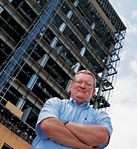 |
 |
||||||
|
|
|
|
|
THE STORMY SKIES DIDN'T STOP BENBRROK resident Keith Wells (’91) from taking his two children out for dinner last March 28. However, before they could eat, Wells’ work pager sounded. After the children were safely at home, he drove through high water to downtown Fort Worth — which had just been severely damaged by a tornado. Entering the city, Wells could see that the Bank One and UPR Plaza towers had gaping holes from blown-out windows. Wells, who is the assistant emergency management coordinator for the Fort Worth/Tarrant County Emergency Management Office, headed straight to the Emergency Operations Center in the basement of City Hall. He stayed there for most of the next 36 hours, coordinating police and fire departments, utility and phone companies, and the Red Cross and other agencies. “I arrived between 6:45 and 7 p.m., shortly after the tornado hit downtown, and didn’t leave until 2 a.m. I was back at 6 a.m., left at 11 p.m. and was back at 6 a.m.,” says Wells, a graduate of UNT’s emergency administration and planning program. “Everything is now a blur.” The Emergency Operations Center is only activated for widespread disasters, which are classified from Level 1 to Level 4. The tornado — the first deadly one in Fort Worth’s history — was a Level 4 activation disaster.
From economics to emergencies Wells attended the University of Texas at El Paso before transferring to UNT. He majored in economics and business but dropped out in 1980 to work for Southwestern Bell. He returned nine years later, planning to finish his bachelor’s degree in business. One of his classmates was in the emergency administration and planning program, which sparked his interest in the field. Wells visited with three of the program’s faculty members — Tom Joslin, Bob Reed and David Neal. “Before I left the office, I was an emergency administration and planning major,” he says. His first job was with the Texas Department of Public Safety’s division of emergency management. Wells was assigned to the U.S. Department of Energy’s nuclear weapons facility in Amarillo. He later worked for the contractor that operated the plant. “I primarily focused on what would happen during a nuclear disaster,” Wells says. After more than seven years with the public safety department, Wells joined the Fort Worth/Tarrant County Emergency Management Office in March 1999. “I was ready for more variety, and I have it here,” he says. In September 1999, he assisted in response to mass shootings at Fort Worth’s Wedgwood Baptist Church. He also served as the Y2K coordinator for the Fort Worth Fire Department, dealt with the tornado in March and coordinated damage assessment of floods in White Settlement and other Tarrant County communities in June. “Every three months, we seem to have a new disaster,” Wells says. He says that the UNT program’s emphasis on concepts prepared him to respond to the tornado. “I wasn’t taught to actually become a city emergency manager. Instead, I learned ways to think and analyze situations. When I graduated, I was confident that I could do any job,” he says.
Tornado aftermath In the first hours following the tornado, Wells and the emergency management staff feared many people were trapped in damaged buildings. They sent out search and rescue teams, and city crews were sent out to clear debris from streets. By the morning of March 30, the Emergency Operations Center had found no trapped people, and the focus turned to managing access to the buildings, routing traffic and securing funds for rebuilding homes and businesses. As part of his job to help the city qualify for government disaster assistance, Wells took federal and state officials on a preliminary assessment tour of Fort Worth — the first step to a disaster declaration. It was his first look at the widespread destruction. “I was amazed that more people were not killed or injured,” he says. “We had five deaths, with only two directly from the tornado, and 95 injuries. Only five of those injuries were serious.” Wells says most people in the tornado’s path “did exactly what they were supposed to do” — they sought safety in interior rooms and stairwells. “The biggest mistake people make is not learning how to be prepared,” he says. “As early as 9 a.m. that day, radio stations said there was a good chance for severe weather. With a tornado, you can’t wait until the last minute to plan for shelter.” When Fort Worth was declared a federal disaster area days after the tornado, Wells felt a sense of achievement — particularly for the residents of the low-income Linwood neighborhood. “I talked to the residents and heard stories about what they had lost, and it was sad. It made me want to help them so much more,” he says. “The best
part of this job is helping people pick up their lives and start
over through giving them the assistance to rebuild.”
|
||||||||||||||

